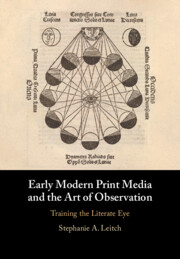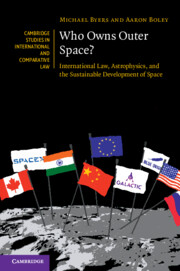120 results
16 - Hipparchos of Nikaia
- from Part III - Hellenistic Period
-
- Book:
- Geographers of the Ancient Greek World
- Published online:
- 25 March 2024
- Print publication:
- 18 April 2024, pp 441-465
-
- Chapter
- Export citation

Early Modern Print Media and the Art of Observation
- Training the Literate Eye
-
- Published online:
- 14 March 2024
- Print publication:
- 04 April 2024
10 - Scientific Communities and the Emergence of Science in Early Modern Japan
- from PART II - Economy, Environment, and Technology
-
-
- Book:
- The New Cambridge History of Japan
- Published online:
- 15 January 2024
- Print publication:
- 23 November 2023, pp 342-362
-
- Chapter
- Export citation
11 - Scientific Exchange
- from Volume I Part 2 - Thematic Histories
-
-
- Book:
- The Cambridge History of the Mongol Empire
- Published online:
- 01 January 2024
- Print publication:
- 17 August 2023, pp 550-574
-
- Chapter
- Export citation
The Maya 819-Day Count and Planetary Astronomy
-
- Journal:
- Ancient Mesoamerica / Volume 34 / Issue 3 / Fall 2023
- Published online by Cambridge University Press:
- 18 April 2023, pp. 690-700
- Print publication:
- Fall 2023
-
- Article
- Export citation
2 - Mega-constellations
-
- Book:
- Who Owns Outer Space?
- Published online:
- 06 April 2023
- Print publication:
- 13 April 2023, pp 46-76
-
- Chapter
-
- You have access
- Open access
- HTML
- Export citation
3 - Mega-constellations and International Law
-
- Book:
- Who Owns Outer Space?
- Published online:
- 06 April 2023
- Print publication:
- 13 April 2023, pp 77-113
-
- Chapter
-
- You have access
- Open access
- HTML
- Export citation
6 - Planetary Defence
-
- Book:
- Who Owns Outer Space?
- Published online:
- 06 April 2023
- Print publication:
- 13 April 2023, pp 186-257
-
- Chapter
-
- You have access
- Open access
- HTML
- Export citation

Who Owns Outer Space?
- International Law, Astrophysics, and the Sustainable Development of Space
-
- Published online:
- 06 April 2023
- Print publication:
- 13 April 2023
-
- Book
-
- You have access
- Open access
- Export citation
Chapter 15 - Science
- from Part III - Culture
-
-
- Book:
- Chekhov in Context
- Published online:
- 16 February 2023
- Print publication:
- 23 February 2023, pp 116-122
-
- Chapter
- Export citation
Chapter 10 - Lucretius on the Size of the Sun
- from Part II - Epicurus and Lucretian Postures
-
-
- Book:
- Epicurus in Rome
- Published online:
- 13 January 2023
- Print publication:
- 09 February 2023, pp 168-185
-
- Chapter
-
- You have access
- Open access
- HTML
- Export citation
10 - Cultural and intellectual life, 1600–1789
- from Part II
-
- Book:
- Early Modern Europe, 1450–1789
- Published online:
- 30 August 2022
- Print publication:
- 25 August 2022, pp 383-428
-
- Chapter
- Export citation
3 - Decoding the Heavens: The Antikythera Machine
-
-
- Book:
- Enigmas
- Published online:
- 01 September 2022
- Print publication:
- 18 August 2022, pp 58-81
-
- Chapter
- Export citation
12 - Betwixt and Between: Plato and the Objects of Mathematics
-
-
- Book:
- The Cambridge Companion to Plato
- Published online:
- 21 July 2022
- Print publication:
- 04 August 2022, pp 358-398
-
- Chapter
- Export citation
Laboratory Astrophysics Activities IAU Commission B5 2022 GA
-
- Journal:
- Proceedings of the International Astronomical Union / Volume 18 / Issue S371 / August 2022
- Published online by Cambridge University Press:
- 19 March 2024, pp. 49-53
- Print publication:
- August 2022
-
- Article
- Export citation
18 - Undergraduate Research in Physics
- from Part III.1 - STEM
-
-
- Book:
- The Cambridge Handbook of Undergraduate Research
- Published online:
- 11 August 2022
- Print publication:
- 07 July 2022, pp 191-198
-
- Chapter
- Export citation
6 - “How Much from the Point”: Saving Appearances at the Edge of the Universe
-
- Book:
- Believing in Dante
- Published online:
- 10 June 2022
- Print publication:
- 30 June 2022, pp 208-243
-
- Chapter
- Export citation
5 - Astral Commentaries within the Mesopotamian Received Tradition
- from Comparing Commentaries
-
-
- Book:
- Mathematical Commentaries in the Ancient World
- Published online:
- 02 June 2022
- Print publication:
- 09 June 2022, pp 199-277
-
- Chapter
- Export citation
3 - Dividing the East: Post-Chinggisid World Orders
- from Part I - Cihannüma
-
- Book:
- Before the West
- Published online:
- 24 February 2022
- Print publication:
- 03 March 2022, pp 89-123
-
- Chapter
- Export citation
For Whom Hesperus Shines: An Astronomical Allusion in Roman Epithalamic Poetry
-
- Journal:
- The Journal of Roman Studies / Volume 112 / November 2022
- Published online by Cambridge University Press:
- 18 February 2022, pp. 39-56
- Print publication:
- November 2022
-
- Article
-
- You have access
- Open access
- HTML
- Export citation



